[English] 日本語
 Yorodumi
Yorodumi- PDB-7zq9: Dimeric PSI of Chlamydomonas reinhardtii at 2.74 A resolution (sy... -
+ Open data
Open data
- Basic information
Basic information
| Entry | Database: PDB / ID: 7zq9 | |||||||||||||||
|---|---|---|---|---|---|---|---|---|---|---|---|---|---|---|---|---|
| Title | Dimeric PSI of Chlamydomonas reinhardtii at 2.74 A resolution (symmetry expanded) | |||||||||||||||
 Components Components |
| |||||||||||||||
 Keywords Keywords | PHOTOSYNTHESIS / green algae / dimeric PSI | |||||||||||||||
| Function / homology |  Function and homology information Function and homology informationphotosynthesis, light harvesting in photosystem I / chloroplast thylakoid lumen / photosynthesis, light harvesting / photosystem I reaction center / photosystem I / photosynthetic electron transport in photosystem I / photosystem I / photosystem II / chlorophyll binding / chloroplast thylakoid membrane ...photosynthesis, light harvesting in photosystem I / chloroplast thylakoid lumen / photosynthesis, light harvesting / photosystem I reaction center / photosystem I / photosynthetic electron transport in photosystem I / photosystem I / photosystem II / chlorophyll binding / chloroplast thylakoid membrane / response to light stimulus / photosynthesis / 4 iron, 4 sulfur cluster binding / electron transfer activity / oxidoreductase activity / magnesium ion binding / metal ion binding Similarity search - Function | |||||||||||||||
| Biological species |  | |||||||||||||||
| Method | ELECTRON MICROSCOPY / single particle reconstruction / cryo EM / Resolution: 2.74 Å | |||||||||||||||
 Authors Authors | Naschberger, A. / Amunts, A. | |||||||||||||||
| Funding support |  Sweden, Sweden,  Germany, 4items Germany, 4items
| |||||||||||||||
 Citation Citation |  Journal: Nat Plants / Year: 2022 Journal: Nat Plants / Year: 2022Title: Algal photosystem I dimer and high-resolution model of PSI-plastocyanin complex. Authors: Andreas Naschberger / Laura Mosebach / Victor Tobiasson / Sebastian Kuhlgert / Martin Scholz / Annemarie Perez-Boerema / Thi Thu Hoai Ho / André Vidal-Meireles / Yuichiro Takahashi / ...Authors: Andreas Naschberger / Laura Mosebach / Victor Tobiasson / Sebastian Kuhlgert / Martin Scholz / Annemarie Perez-Boerema / Thi Thu Hoai Ho / André Vidal-Meireles / Yuichiro Takahashi / Michael Hippler / Alexey Amunts /     Abstract: Photosystem I (PSI) enables photo-electron transfer and regulates photosynthesis in the bioenergetic membranes of cyanobacteria and chloroplasts. Being a multi-subunit complex, its macromolecular ...Photosystem I (PSI) enables photo-electron transfer and regulates photosynthesis in the bioenergetic membranes of cyanobacteria and chloroplasts. Being a multi-subunit complex, its macromolecular organization affects the dynamics of photosynthetic membranes. Here we reveal a chloroplast PSI from the green alga Chlamydomonas reinhardtii that is organized as a homodimer, comprising 40 protein subunits with 118 transmembrane helices that provide scaffold for 568 pigments. Cryogenic electron microscopy identified that the absence of PsaH and Lhca2 gives rise to a head-to-head relative orientation of the PSI-light-harvesting complex I monomers in a way that is essentially different from the oligomer formation in cyanobacteria. The light-harvesting protein Lhca9 is the key element for mediating this dimerization. The interface between the monomers is lacking PsaH and thus partially overlaps with the surface area that would bind one of the light-harvesting complex II complexes in state transitions. We also define the most accurate available PSI-light-harvesting complex I model at 2.3 Å resolution, including a flexibly bound electron donor plastocyanin, and assign correct identities and orientations to all the pigments, as well as 621 water molecules that affect energy transfer pathways. | |||||||||||||||
| History |
|
- Structure visualization
Structure visualization
| Structure viewer | Molecule:  Molmil Molmil Jmol/JSmol Jmol/JSmol |
|---|
- Downloads & links
Downloads & links
- Download
Download
| PDBx/mmCIF format |  7zq9.cif.gz 7zq9.cif.gz | 2.3 MB | Display |  PDBx/mmCIF format PDBx/mmCIF format |
|---|---|---|---|---|
| PDB format |  pdb7zq9.ent.gz pdb7zq9.ent.gz | Display |  PDB format PDB format | |
| PDBx/mmJSON format |  7zq9.json.gz 7zq9.json.gz | Tree view |  PDBx/mmJSON format PDBx/mmJSON format | |
| Others |  Other downloads Other downloads |
-Validation report
| Summary document |  7zq9_validation.pdf.gz 7zq9_validation.pdf.gz | 21.6 MB | Display |  wwPDB validaton report wwPDB validaton report |
|---|---|---|---|---|
| Full document |  7zq9_full_validation.pdf.gz 7zq9_full_validation.pdf.gz | 21.9 MB | Display | |
| Data in XML |  7zq9_validation.xml.gz 7zq9_validation.xml.gz | 195.6 KB | Display | |
| Data in CIF |  7zq9_validation.cif.gz 7zq9_validation.cif.gz | 264.6 KB | Display | |
| Arichive directory |  https://data.pdbj.org/pub/pdb/validation_reports/zq/7zq9 https://data.pdbj.org/pub/pdb/validation_reports/zq/7zq9 ftp://data.pdbj.org/pub/pdb/validation_reports/zq/7zq9 ftp://data.pdbj.org/pub/pdb/validation_reports/zq/7zq9 | HTTPS FTP |
-Related structure data
| Related structure data |  14867MC 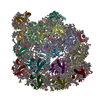 7zqcC 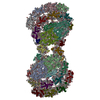 7zqdC  7zqeC M: map data used to model this data C: citing same article ( |
|---|---|
| Similar structure data | Similarity search - Function & homology  F&H Search F&H Search |
- Links
Links
- Assembly
Assembly
| Deposited unit | 
|
|---|---|
| 1 |
|
- Components
Components
-Photosystem I P700 chlorophyll a apoprotein ... , 3 types, 3 molecules ABB2
| #1: Protein | Mass: 83239.203 Da / Num. of mol.: 1 / Source method: isolated from a natural source / Source: (natural)  |
|---|---|
| #2: Protein | Mass: 82184.266 Da / Num. of mol.: 1 / Source method: isolated from a natural source / Source: (natural)  |
| #20: Protein | Mass: 20637.457 Da / Num. of mol.: 1 / Source method: isolated from a natural source / Source: (natural)  |
-Protein , 2 types, 3 molecules CLL2
| #3: Protein | Mass: 8869.325 Da / Num. of mol.: 1 / Source method: isolated from a natural source / Source: (natural)  |
|---|---|
| #10: Protein | Mass: 20300.539 Da / Num. of mol.: 2 / Source method: isolated from a natural source / Source: (natural)  |
-Photosystem I reaction center subunit ... , 7 types, 8 molecules DEFGII2JK
| #4: Protein | Mass: 21372.887 Da / Num. of mol.: 1 / Source method: isolated from a natural source / Source: (natural)  | ||||
|---|---|---|---|---|---|
| #5: Protein | Mass: 10786.395 Da / Num. of mol.: 1 / Source method: isolated from a natural source / Source: (natural)  | ||||
| #6: Protein | Mass: 24088.936 Da / Num. of mol.: 1 / Source method: isolated from a natural source / Source: (natural)  | ||||
| #7: Protein | Mass: 13236.007 Da / Num. of mol.: 1 / Source method: isolated from a natural source / Source: (natural)  | ||||
| #8: Protein | Mass: 10586.388 Da / Num. of mol.: 2 / Source method: isolated from a natural source / Source: (natural)  #9: Protein/peptide | | Mass: 4645.372 Da / Num. of mol.: 1 / Source method: isolated from a natural source / Source: (natural)  #11: Protein | | Mass: 11214.084 Da / Num. of mol.: 1 / Source method: isolated from a natural source / Source: (natural)  |
-Chlorophyll a-b binding protein, ... , 8 types, 10 molecules 1Z378456992
| #12: Protein | Mass: 23923.205 Da / Num. of mol.: 2 / Source method: isolated from a natural source / Source: (natural)  #13: Protein | | Mass: 32629.486 Da / Num. of mol.: 1 / Source method: isolated from a natural source / Source: (natural)  #14: Protein | | Mass: 26248.869 Da / Num. of mol.: 1 / Source method: isolated from a natural source / Source: (natural)  #15: Protein | | Mass: 25948.812 Da / Num. of mol.: 1 / Source method: isolated from a natural source / Source: (natural)  #16: Protein | | Mass: 28729.822 Da / Num. of mol.: 1 / Source method: isolated from a natural source / Source: (natural)  #17: Protein | | Mass: 28257.555 Da / Num. of mol.: 1 / Source method: isolated from a natural source / Source: (natural)  #18: Protein | | Mass: 27812.373 Da / Num. of mol.: 1 / Source method: isolated from a natural source / Source: (natural)  #19: Protein | Mass: 22867.277 Da / Num. of mol.: 2 / Source method: isolated from a natural source / Source: (natural)  |
|---|
-Sugars , 2 types, 35 molecules 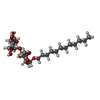


| #27: Sugar | ChemComp-LMU / #30: Sugar | ChemComp-DGD / | |
|---|
-Non-polymers , 12 types, 450 molecules 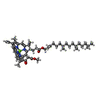

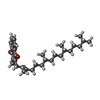




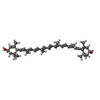
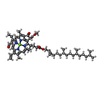
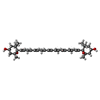
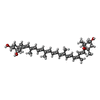












| #21: Chemical | ChemComp-CL0 / | ||||||||||||||||||||
|---|---|---|---|---|---|---|---|---|---|---|---|---|---|---|---|---|---|---|---|---|---|
| #22: Chemical | ChemComp-CLA / #23: Chemical | #24: Chemical | ChemComp-LHG / #25: Chemical | ChemComp-BCR / #26: Chemical | #28: Chemical | ChemComp-LMG / #29: Chemical | ChemComp-LUT / ( #31: Chemical | ChemComp-CHL / #32: Chemical | ChemComp-XAT / ( #33: Chemical | #34: Water | ChemComp-HOH / | |
-Details
| Has ligand of interest | Y |
|---|
-Experimental details
-Experiment
| Experiment | Method: ELECTRON MICROSCOPY |
|---|---|
| EM experiment | Aggregation state: PARTICLE / 3D reconstruction method: single particle reconstruction |
- Sample preparation
Sample preparation
| Component | Name: Photosystem I dimer of Chlamydomonas reinhardtii / Type: ORGANELLE OR CELLULAR COMPONENT / Entity ID: #1-#20 / Source: NATURAL |
|---|---|
| Molecular weight | Value: 0.7 MDa / Experimental value: YES |
| Source (natural) | Organism:  |
| Buffer solution | pH: 7.5 |
| Specimen | Embedding applied: NO / Shadowing applied: NO / Staining applied: NO / Vitrification applied: YES |
| Vitrification | Cryogen name: ETHANE |
- Electron microscopy imaging
Electron microscopy imaging
| Experimental equipment |  Model: Titan Krios / Image courtesy: FEI Company |
|---|---|
| Microscopy | Model: FEI TITAN KRIOS |
| Electron gun | Electron source:  FIELD EMISSION GUN / Accelerating voltage: 300 kV / Illumination mode: FLOOD BEAM FIELD EMISSION GUN / Accelerating voltage: 300 kV / Illumination mode: FLOOD BEAM |
| Electron lens | Mode: BRIGHT FIELD / Nominal defocus max: 5000 nm / Nominal defocus min: 1000 nm |
| Image recording | Electron dose: 45.8 e/Å2 / Film or detector model: GATAN K3 BIOQUANTUM (6k x 4k) |
- Processing
Processing
| CTF correction | Type: PHASE FLIPPING ONLY |
|---|---|
| 3D reconstruction | Resolution: 2.74 Å / Resolution method: FSC 0.143 CUT-OFF / Num. of particles: 28346 / Symmetry type: POINT |
 Movie
Movie Controller
Controller





 PDBj
PDBj






















